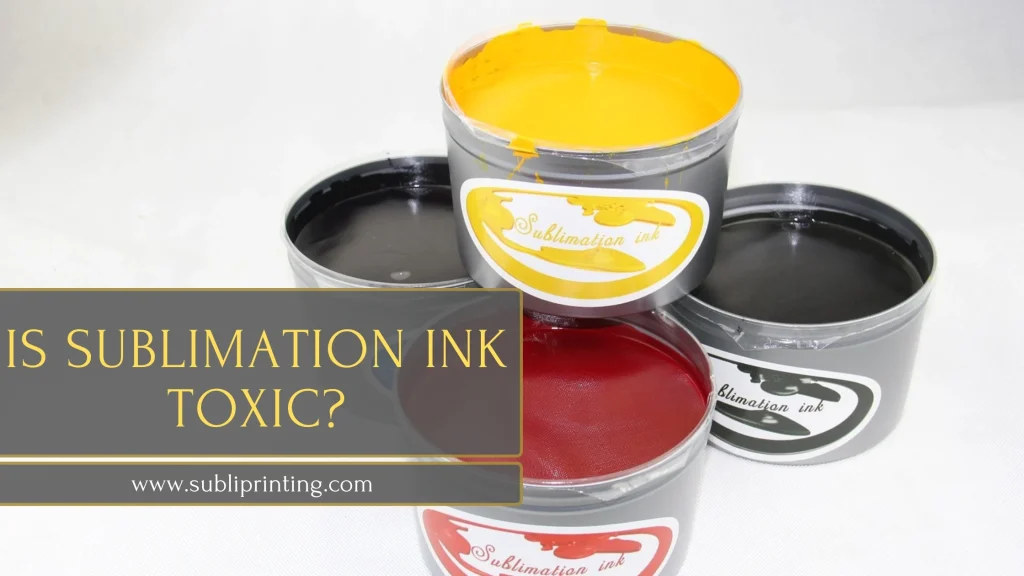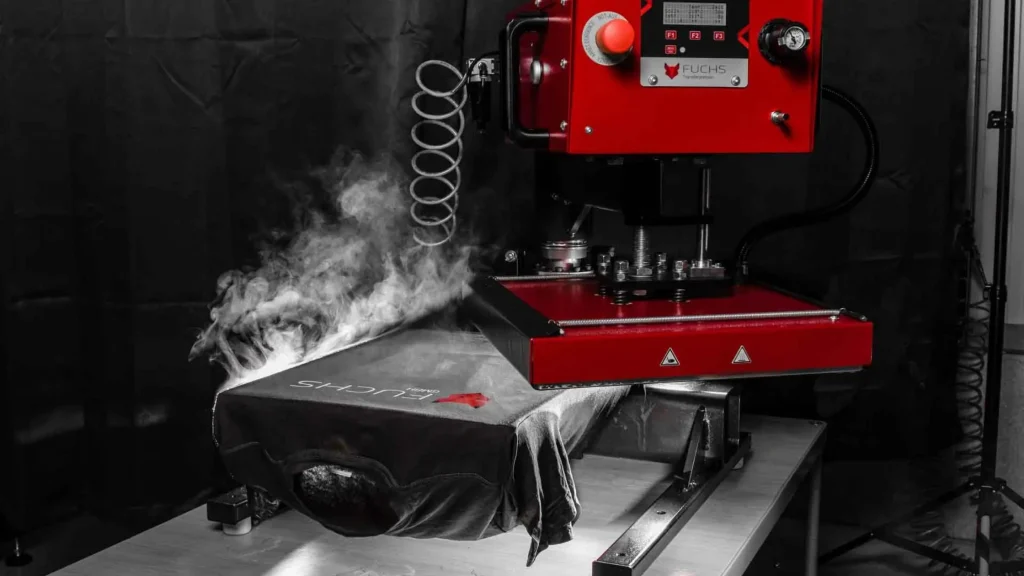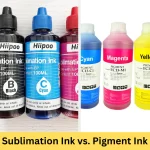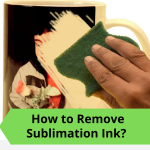Seeing sublimation prints on vibrant mugs, phone cases, and T-shirts is like magic, right? But then you read health risks of chemicals in sublimation ink on some forum and wonder: “Is sublimation ink toxic”? And, a panic sets in while grabbing your favorite sublimated mug as if your DIY passion secretly poisoning you?
No, generally a good quality sublimation ink is not toxic to human. It does not contain any harmful chemical that can be dangerous to health in a short or long run. However, poor quality sublimation ink from cheap brands cause fumes which can create health hazards, such as disturbance in respiratory system and eye irritation.
That’s why we always recommend using high quality sublimation ink from reliable brands.
Contents
- Is Sublimation Ink Toxic for Human?
- Sublimation Ink Components and Health Risks
- Health Risks of Sublimation Ink and Precautions
- Sublimation Ink and Specific Concerns
- Sublimation Printing Eco-Friendliness
- Is Sublimation Ink Toxic When Heated?
- Non-Toxic and Eco-Friendly Sublimation Ink Brands
- Final Thoughts
- Frequently Asked Questions
Is Sublimation Ink Toxic for Human?
Most sublimation inks are not toxic and considered safe for human. These inks are created using harmless chemicals, which are not poisoning at all. But some cheap quality non-branded sublimation dyes might contain harsh chemicals which cause harmful fumes, making them toxic for human.
These fumes can affect a human body through inhalation and cause damage to respiratory system, eye and skin irritation, and other health risks.
Having problem with your sublimated prints? Get the best sublimation printer and design your items with ease.
Sublimation Ink Components and Health Risks
The components and health risks may vary depending on the form of sublimation ink. Based on solvent types, basically, there are two forms of sublimation ink – Aqueous-based dye sublimation ink and Solvent sublimation ink. These types differ in the ingredients that are suspended in water and oil, respectively.
Aqueous-Based Dye Sublimation Ink: This type uses water as the primary carrier, making it more eco-friendly and generally odorless. It might offer slightly less vibrant colors than solvent inks but is often preferred for home use and projects involving children or pets due to its safer profile.
Solvent Sublimation Ink: These inks use a solvent as a carrier for the dye, typically glycol ethers or aliphatic hydrocarbons. It’s known for its vibrant colors and fast drying times, but also has a stronger odor and requires more thorough ventilation due to the solvent fumes.
Some of the solvent-based sublimation dyes I tried caused fumes, and also released weird smell while heat transfer process. Even though they produce vibrant results on final products, but still, I avoid them for health concerns and advise opting for aqueous based sublimation ink.
Let’s explore their components in details along with health risks, if any.
Aqueous-Based Dye Sublimation Ink
| Ingredient | Amount in ink formation | Health risks |
| Water | 30-90% | None |
| Dyes Pigments | 3-10% | None |
| Co-Solvents (Glycols, Isopropyl alcohol, Propylene glycol) | 5-40% | Minimal (Ignorable) |
| Glycerin | 1-5% | None |
| Plasticizers (non-phthalate alternatives) | 2-5% | Generally safe |
| Xanthan gum (thickener) | 0.01-1% | Mild skin irritation (rare) |
| Biocides (propiconazole) | 0-0.5% | Potential endocrine disruption, allergic reactions (when inhaled) |
Solvent-Based Dye Sublimation Ink
| Ingredient | Percentage | Health risks |
| Oil | 70-90% | Yes, only when inhaled |
| Dyes Particles | 3-10% | None |
| Esters (N-butyl acetate) | 0-2.5% | Respiratory irritation, eye irritation (if inhaled or ingested) |
| Chloride-vinyl acetate copolymer | 2-6% | Skin irritation, eye irritation, respiratory problems (if inhaled or ingested) |
| Polymeric amide | 0-4% | None |
| 2-methoxy-1-methyl ethyl | 0-1.25% | Eye irritation, skin dryness, respiratory problems (if inhaled or ingested) |
| Ketones (Ethyl acetate) | 0-4% | Respiratory irritation, eye irritation, skin irritation (if inhaled or ingested) |
| Biocides (CMIT/MIT) | 0-0.5% | Potential skin and respiratory irritation, allergic reactions (if inhaled or ingested) |
| Antifoaming agents | 0-1% | Mild eye and respiratory irritation (rare) |
Note: The percentage and some ingredients may vary depending on the brand of sublimation ink. We advise reading the ingredients first before purchasing dyes.
However, reputable brands keep the number of toxic components (and amount) as low as possible to avoid any harm to human bodies. But still, always take precautions while using solvent based sublimation dyes.
Also, read the difference between Sublimation ink vs Pigment ink.
Health Risks of Sublimation Ink and Precautions
Sublimation ink is generally safe to use, but it can pose some health risks if it is not handled properly or if it comes into contact with the human body. Let’s discuss the main health risks of sublimation ink and the precautions to take to avoid them.
a. Skin Problems
One of the main health risks of sublimation ink is skin contact. Sublimation ink can cause skin irritation, redness, itching, or rash if it touches the skin. This is because some of the chemicals in sublimation ink may be irritants or sensitizers, which means they can cause inflammation or allergies in some people.
Skin contact with sublimation ink can also increase the risk of infection or dermatitis if the skin is broken or damaged.
You should always wear protective gloves and clothing when handling sublimation ink to prevent skin contact. Furthermore, wash your hands thoroughly after sublimation and before touching your face or other parts of your body.
If you accidentally spill or leak sublimation ink on your skin, you should wash it off immediately with plenty of soap and water.
b. Eye Problems
Sublimation ink can cause eye irritation, burning, tearing, or blurred vision if it gets into the eyes. Both aqueous and solvent based inks contain some chemicals that are corrosive or abrasive, and they can damage the delicate tissues of the eyes.
We advise wearing protective goggles while doing sublimation. Also, avoid rubbing or touching your eyes when working with sublimation ink.
c. Inhalation
As your heat press your sublimation print to transfer it on the substrate, volatile organic compounds (VOCs) might release in the air. These fumes can cause headaches and respiratory problems, such as coughing, wheezing, shortness of breath, or asthma if it is inhaled.
Inhalation of fumes from sublimation ink can also increase the risk of lung infection or cancer if the chemicals are carcinogenic or mutagenic (but that’s only if you’ve been inhaling it for a while).
The best practice is to work in a well-ventilated area and avoid breathing in the sublimation ink gas. Open windows and switch on exhaust fans. The more air, the safer the atmosphere.
If you do a lot of sublimation, you should wear a mask, especially when doing the heat press.
d. Ingestion
Let’s keep it straight – ingesting sublimation ink is a BIG NO! It can be toxic and poisoning, leading to digestive problems, such as nausea, vomiting, diarrhea, and even more unpleasant surprises. Keep ink out of reach of children and pets, treating it like the buried treasure it is – meant for creative adventures, not stomach exploration.
If in any case, you have swallowed sublimation ink, immediately call the poison control center or ask someone to take you to the nearest hospital.
Here’s a guide to remove sublimation ink safely.
Sublimation Ink and Specific Concerns
1. Pregnancy
Pregnant women love to create personalized garments for their unborn babies and the fathers to be. They often ask if they can do sublimation while pregnant. Yes, sublimation dyes poses minimal risks and are not toxic for pregnant women, they can sublimate while expecting. However, they should wear PPE and strictly follow the safety precautions and instructions.
Some of the tips that pregnant women can follow when using sublimation ink are:
- Wear personal protective equipment (PPE), such as protective gloves, clothing, goggles, and mask when handling sublimation ink.
- Work in a well-ventilated area and avoid breathing in the fumes or vapors of sublimation ink.
- Wash hands thoroughly after handling sublimation ink and before eating or drinking anything.
- Do not eat or drink anything when working with sublimation ink.
- Do not swallow or inhale sublimation ink.
2. Babies and Children
Tiny fingers and curious noses – they’re drawn to everything. And if you are working from home, it is definite that your babies will crawl to your work space and touch whatever they find in front, most chances are your recently sublimated substrate.
So, should they be off-limits? Not necessarily! Seek out inks with FDA and RoHS certifications, guaranteeing they’re free of harmful chemicals.
3. Food Safety
Consumers may wonder if sublimation ink is edible or if it is safe to use sublimation printing to create mugs, plates, or other items that come into contact with food or beverages. Well, generally, sublimation ink is not edible and it is not recommended to ingest it. It can cause digestive problems if it is swallowed. And the worst case? It can also cause liver or kidney damage if it is absorbed into the bloodstream.
However, there’s a glimmer of hope for those who dream of food-safe prints. Certain mugs and plates can be sublimated with FDA-approved high-quality sublimation inks specifically designed for food contact. And, ensure proper heat treatment during the heat-press process.
But, we still advise sticking to decorative items used for occasional snacks or drinks. Avoid using sublimated plates for everyday meals or storing food for extended periods.
4. Pets
Just like human, sublimation ink poses minimal risk to pets and generally considered safe. While the risks are minimal with proper handling and ventilation, a little caution is always a good idea. Store your inks securely, away from curious paws and nose.
After printing, ensure good ventilation to dissipate any lingering fumes that might be tempting to sniff or lick. Also, keep watchful eye when your pet is around your sublimated creations. If they show any interest in chewing or ingesting the material, promptly redirect their attention to safer toys.
Sublimation Printing Eco-Friendliness
Sublimation printing is not only a versatile and creative technique, but also an eco-friendly one method. Comparing to other popular printing methods, such as DTG, screen printing, and air-brushing, sublimation poses the most eco-friendliness nature. Here’s why:
Sublimation relies on one dye that transforms with heat, unlike traditional printing methods that use a rainbow of inks for each color. This translates to less ink production, less ink waste, and ultimately, a smaller environmental footprint.
In addition, many sublimation inks are water-based, free from those nasty solvent fumes and VOCs (Volatile Organic Compounds) that can pollute the air and harm our health.
However, to ensure not to harm the environment in any case, don’t just toss those empty ink bottles overboard! Dispose the empty sublimation ink cartridges (tanks) in a recycle bin, rather than throwing it in your waste bin, they might end up in an ocean, polluting our precious waters.
Is Sublimation Ink Toxic When Heated?
Sublimation ink itself is not inherently toxic when heated, just make sure to use sublimation dyes from reputable brands – and not any cheap or no name dyes. This is because poor quality sublimation ink can cause toxic fumes under heat, and they can be dangerous to health when inhaled.
Non-Toxic and Eco-Friendly Sublimation Ink Brands
After measuring toxicity of multiple sublimation inks from different brands and consulting sublimation experts (Bo Ram Kim, Jennifer, and Angie), I concluded that the following sublimation ink brands are least toxic to human and animals:
- Printers Jack
- Hiipoo
- WOKOK
- InkOwl Sublimation Ink
- Sublisplash Eco Series
- JetProX
- HiiJet Premium Dye Sublimation Ink
Final Thoughts
In a nutshell, most sublimation inks are not toxic and generally considered safe for human, and pets. Most of the chemicals in water-based sublimation ink don’t harm the human body. However, if you use non-branded, cheap sublimation inks, they can be toxic. These inks produce harmful fumes that can affect the respiratory system through inhalation.
For being on the safest side, always opt for reliable sublimation ink brand, wear protective equipment, such as gloves, goggles, and keep the windows open to maximize the ventilation. NEVER, I repeat, NEVER touch or try to taste sublimation dyes to prevent skin irritation and digestion issues.
Frequently Asked Questions
Is sublimation ink poisonous?
Generally, NO, sublimation ink itself is not poisonous. It primarily consists of dyes, carriers (like water or glycol ethers), plasticizers, and additives. Most dyes and carriers are non-toxic, similar to food coloring.
Are sublimation fumes bad for you?
Yes, Sublimation fumes can be mildly irritating and bad for human when inhaled. While sublimation fumes are typically low in volatile organic compounds (VOCs), inhaling them directly or in high concentrations can cause respiratory irritation.
- 5 Best 13×19 Sublimation Printer for Wide Format Substrates - December 27, 2023
- Best 11×17 Sublimation Printer to Print Tabloid Size Paper - December 26, 2023
- Epson ET-8550 vs ET-15000: Best Wide-Format EcoTank Printer - December 25, 2023





![What Is Sublimation Ink and How Does It Work? [Read Its Uses] What Is Sublimation Ink](https://subliprinting.com/wp-content/uploads/2022/04/What-is-sublimation-ink-150x150.png)


